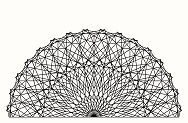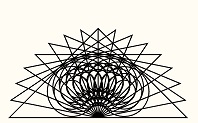


 |
 |
 |
The transition, of course, is the transition from primitive biology to modern biology which occurred 65 million years ago. It needs a lot of clarifying, as biologists haven't quite noticed that it was a transition. In summary, during dinosaur years, all terrestrial biology was being held back from evolving forward by nonwoody brush that covered the lowlands. Dinosaurs had to be large to tromp over the brush, which they ate. Mammals had to stay small to go under and through the brush, and they could not diversify for that reason. Biologists have not drawn these conclusions, because such results cannot be directly observed or measured. The complexities are the cumulative result of the interacting factors. It's not that scientists don't try to make a good guess at what they are studying; it's that they don't study enough diverse subjects for evaluating the interacting factors. Evaluating this subject is somewhat dependent upon an agriculture background and a lot of outdoor experience particularly tromping through old growth forests, such as in Oregon, before they were mowed down. Each forest has it's own characteristics. The Oregon forest was highly diverse due to hot, dry summers and soaking wet winters. A lot of oak formed around the valley rivers, and poison oak in the foothills, due to the hot, dry summers. Between the canopies of Douglas Fir was a highly diverse understory of small plants and brush. Extreme diversity was the result. Extreme diversity means a lot of information. Not only does the nonwoody brush of dinosaur years explain why dinosaurs got large, the size of the dinosaurs shows how pervasive and problematic the nonwoody brush was. Other biologists produce a variety of explanations of why dinosaurs got large, but none of the theories have a correct logic besides the nonwoody brush explanation. Some of the theories mention physiology or nutrition. The thing wrong with those theories is that all animals have similar problems with physiology and nutrition, which doesn't explain why dinosaurs are different. Another problem with such theories is that they are pro-active. They imply, wouldn't it be nice to increase size as a solution to problems. Evolution doesn't take form on a "wouldn't it be nice" basis. Evolution takes form on a basis of environments creating forces which shape the result. It means theorizing on evolution requires looking at environmental influences, not factors which are endogenous to the organism. Toward the end of the dinosaur years, an unusual dinosaur (Anzu wyliei) evolved which was long-legged like a large chicken. It means grass was starting to evolved by the time dinosaurs died out. It shows that dinosaurs could have been smaller and long legged if there had been environments without heavy brush. The basic elements of modern biology were taking form during the dinosaur years but were extremely limited by the overwhelming brush. Not only were mammals waiting for an escape from the oppressive brush, so were flowering plants. There were a few flowering plants, which would have evolved between the conifers on the hills and the brush in the lowlands. There was so little space for flowering plants that they did not show up in fossil evidence until the 1990s. If dinosaurs were milling around on grassy meadows, as artists depict them, flowering plants would have diversified on the nice meadows. The fact that flowering plants were pushed almost into oblivion shows that the grassy meadows didn't exist. Why didn't flowering plants diversity while Anzu wyliei was evolving on grasslands? The reason is because macromorphology can evolve quite easily, while micromorphology and physiology are extremely slow and limited in evolving. So the shape of dinosaurs could change easily, but the functions of flowering plants required much more drastic change in environments for their evolution. My research on the morel mushroom shows how much easier macromorphology evolves than micromorphology and physiology. Dinosaurs would have benefitted from fat for extra weight, but fat didn't exist until the era of modern biology. Dinosaurs were all muscle, skin and bones. Elephants show what the shape would have been with fat production. Elephants are large for tromping through brush, and they use fat for extra weight. The reason why fat did not exist during dinosaur years is because fat storage metabolism was too improbable until yeasts evolved in that direction with their type of physiology. Glucose breaks down from a six-carbon molecule to two two-carbon molecules (plus CO2) through a standard metabolic pathway called glycolysis. The two-carbon compounds usually go into respiration. But yeasts use those two-carbon compounds to fight off competing bacteria. Yeasts evolved from molds in the sugary solutions produced by plants after modern biology began. The fossil evidence for yeasts goes back 50 million years. Bacteria also evolved in the sugary solutions, starting with Streptomyces from the soil, to take the form of "Gram positive" bacteria, which have cell walls similar to Streptomyces. To fight off the bacteria, yeasts used the two-carbon compounds from glycolysis to form ethanol and acetic acid which are excreted into the surrounding solutions. After yeasts run out of sugars for nutrients, they re-absorb the ethanol and acetic acid and use them for energy through respiration. In this way, ethanol and acetic acid are also energy storage molecules. But yeasts can only excrete a limited amount of ethanol and acetic acid without making conditions too extreme for themselves. So they store the extra two-carbon molecules by linking them together into chains; and abracadabra, they have fat production from the chains created by two-carbon molecules. Through horizontal gene transfer, fat production spread from yeasts to all other species sometime after yeasts evolved before 50 million years ago. Evolution scientists don't assume they find the oldest fossils that could exist and evolution of characteristics goes back farther than the fossils which they find. So the time of fat evolution from yeasts would go back some unknown time farther than 50 million years ago. Most plant seeds store fat as oils to be used as an energy source while geminating. But there are some trees that are so primitive that they do not store fat in their seeds. They also have other primitive characteristics. They include cottonwood trees and willows. Those trees not only produce very small seeds, they have additional primitive characteristics, such as nontapered branches. Most broadleaf trees have tapered branches, because they measure stress and widen where stress is greatest. The stress is always greatest at the starting point of branches, so their branches are widest neat the trunk of the tree. Cottonwood branches are the same width at all points, as are conifers, which evolved 300 million years ago. Willows also do not widen where stress is greatest; instead they use a lot of thin offshoot branches to reduce stress. In other words, cottonwood and willow trees stopped evolving in a major way before trees started to measure stress forces and before seeds started adding oils for energy storage. Those tress stopped evolving as other trees did because they found ideal niches which did not place environmental demands upon them. Both types of trees grow near continuous water supplies, which takes the environmental stress off them as the force causing evolution to occur.
|
|
|||||||||||||||||
 |
 |
 | ||
 |
 |
 |
||